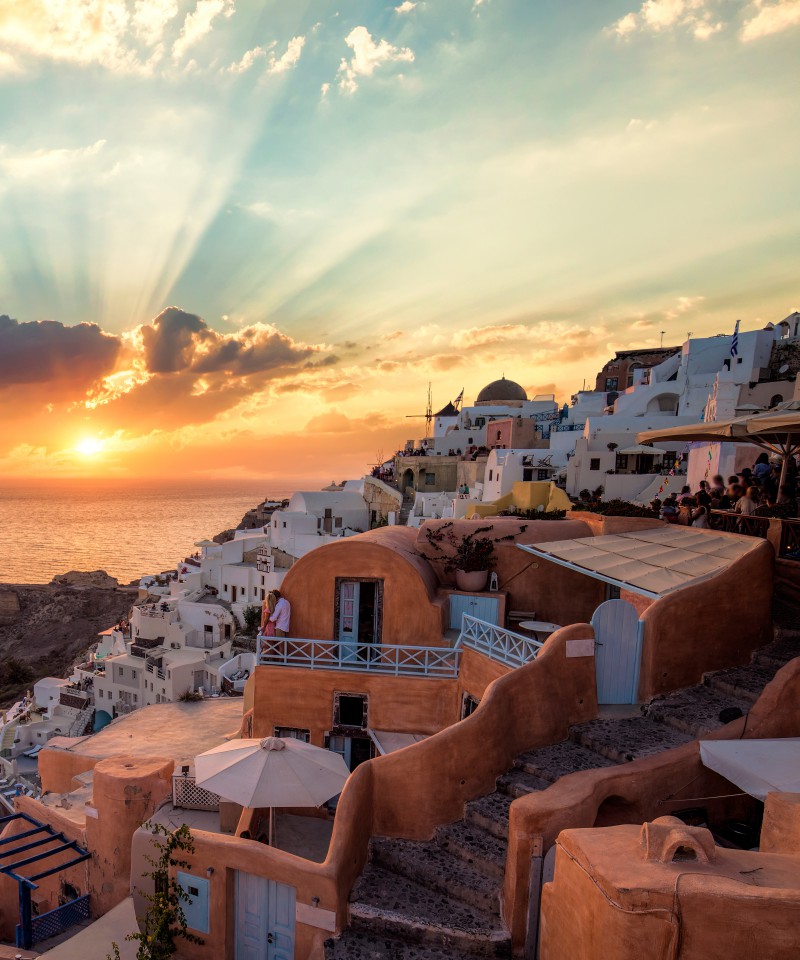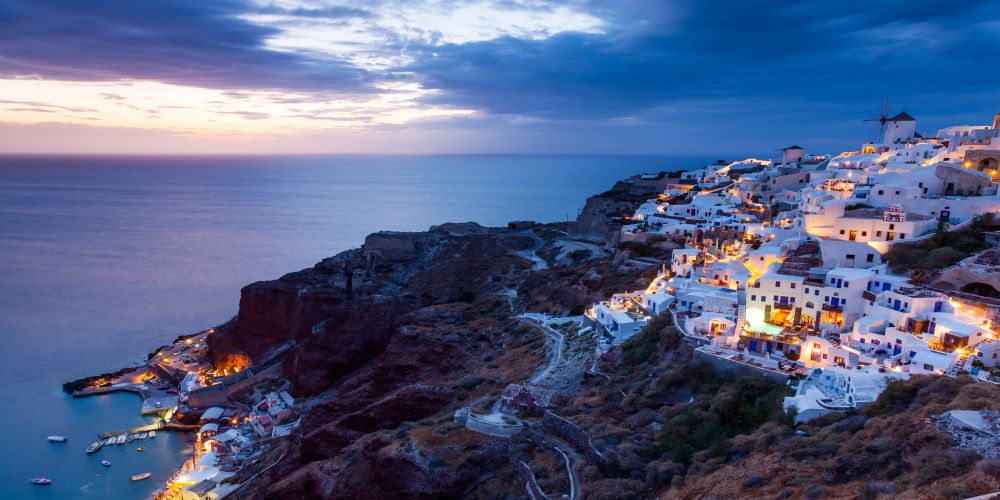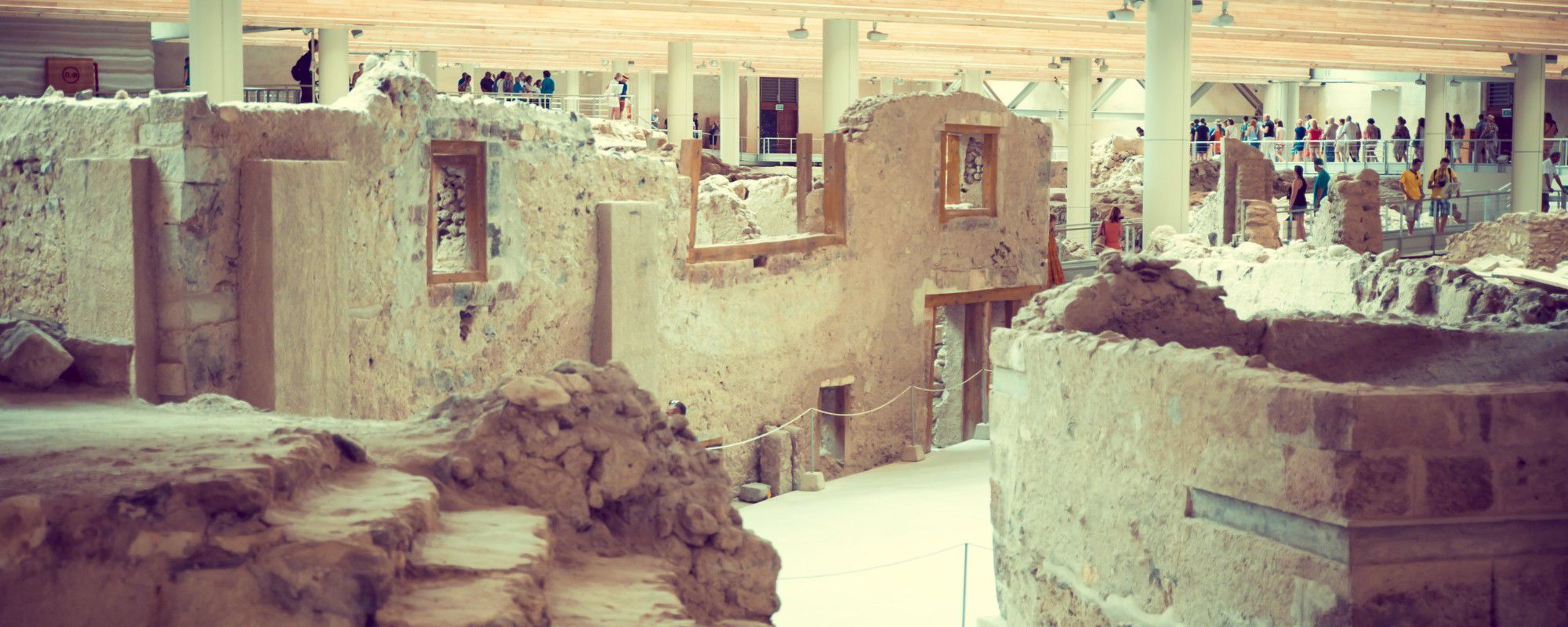
Akrotiri, Santorini: Unveiling the Mysteries of the Ancient Minoan City
Key Takeaways
- Akrotiri in Santorini is an exceptionally well-preserved ancient city that was buried under volcanic ash following a massive eruption around 1600 BCE.
- The city had a sophisticated water management system, paved streets, and an extensive network of trade routes.
- One of the most striking features of Akrotiri is the well-preserved frescoes. These colorful wall paintings depict scenes of daily life, nature, religious rituals, and various mythological figures.
- Akrotiri is an active archaeological site, and ongoing excavations and research contribute to our understanding of the Minoan civilization.
Santorini is one of the most popular and beautiful Greek islands. It is known for its mystifying sunsets, unique beaches, vast wine production, and luxurious lifestyle.
Apart from that, however, one of its biggest characteristics is its rich history that goes back thousands of years. Proof of that is the archaeological site of Akrotiri, which gives insight into an ancient world full of wonder.
Here we will help you discover Akrotiri, the most impressive site in Santorini!
The History of Akrotiri, Santorini

Akrotiri in Santorini is a prehistoric settlement. It was one of the most important centers of the Aegean in prehistoric times that nurtured the island’s culture. The first inhabitants settled in Santorini in the Neolithic Age.
In the following years, the settlement grew, and thanks to its port, it became one of the most important commercial centers of the Aegean. The wealth gave the opportunity to inhabitants of Akrotiri to create a unique culture, over the course of 4000 years, in the Aegean area.
The settlement in Akrotiri stretched across an area of about 200 acres. All the elements of the excavations testify to the high standard of living and the peculiarities of the cultural level of the inhabitants of Akrotiri. The urban planning, the high-rise buildings, the sewerage network, the wonderful murals, show great development and progress.
Akrotiri was a commercial center of the Eastern Mediterranean in full bloom until the time around 1700 -1600 BC when a large eruption of the volcano of Santorini forced its inhabitants to emigrate. Materials from the volcanic eruption covered everything, and the archeological dig came to shed some light as early as the 19th century.
The first systematic excavations in Akrotiri were started by the great Greek archaeologist Spyridon Marinatos in 1967 and continued until his death in 1974. The prehistoric settlement at Akrotiri is one of the most important Greek ruins. Another great Greek archaeologist, Christos Doumas, who continues the work of Marinatos, took over the management of the excavations that continue to this day.
How to get to Akrotiri Archaeological Site
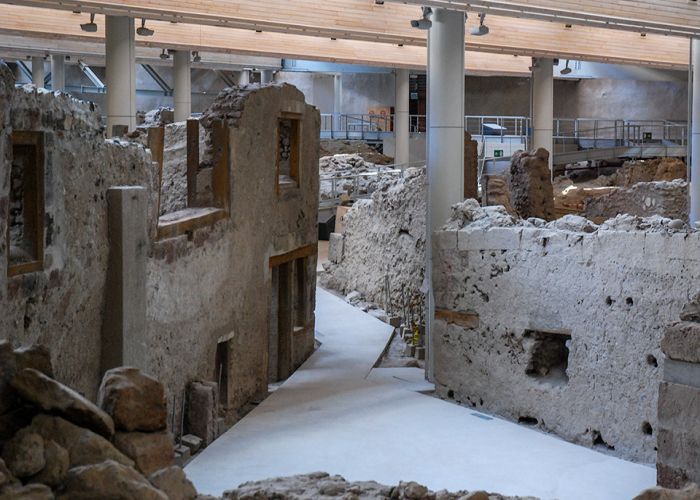
If you want to visit Akrotiri, which is one of the most memorable things to do in Santorini, you’ll be happy to know that you can do so by public transport in addition to your own vehicle. The best way to reach the archaeological site of Akrotiri is by bus. You can catch a bus to Fira and then change to the central bus hub for Akrotiri.
The bus stops at the car park of Akrotiri beach, which is a short 250-meter walk to the archaeological site. The buses are both frequent and reliable. The fares vary from €1.80 - €2.80 depending on where you go. They arrive about every 20 minutes, taking you from Fira to various regions of the island.
If you’re unsure of the bus schedule and the internet is not helpful, don’t hesitate to ask around. The hospitable locals will be more than happy to share their knowledge with you. They might even tell you about a faster way to reach the ancient settlement or even offer to drive you there themselves!
Visiting Akrotiri Archaeological Site in Santorini
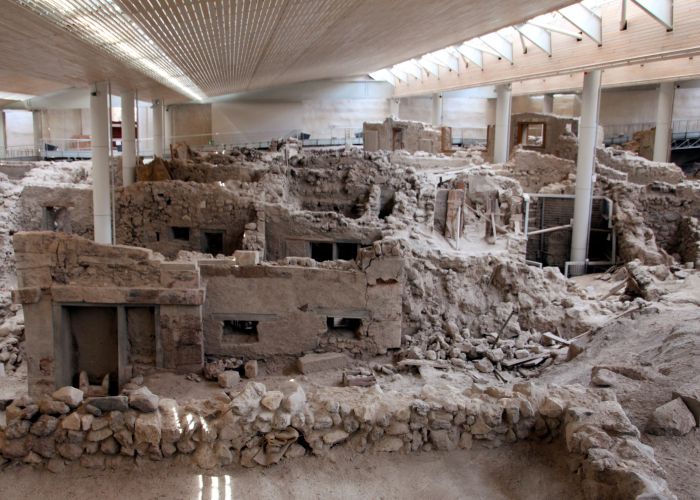
In order to visit Akrotiri, you must be aware of its opening times and ticket fares. The entrance to the archaeological site of Akrotiri will set you back for a regular ticket € 12 and € 6 for a reduced one, which comes in handy if you're visiting Santorini with kids.
You also have the choice of purchasing a single ticket for € 15. The single ticket lasts three days and allows you entrance to most Archaeological Sites and Museums of Thira.
Namely, the Akrotiri Archaeological Site, the Archaeological Site of Ancient Thira, and the Archaeological Museum of Prehistoric Thera. A single ticket can be obtained from the archeological site or the museum.
Luckily, there are certain days of the year when admission is free. Those are the following:
- March 6 - In memory of Melina Mercouri
- April 18 - International Day of Monuments
- May 18 - International Museum Day
- The last weekend of September each year - European Cultural Heritage Days
- The official public holidays of Greece
- October 28
- Every first Sunday of the month from November 1st to March 31st.
Akrotiri’s working hours fluctuate depending on the season. During winter, and specifically from November 6 to March 31, you can visit the site from Wednesday through Monday between 08:30 and 15:30. In the summertime, and specifically from April 15 to October 31, Akrotiri is open from Thursday through Tuesday between 08:00 and 20:00, and on Wednesdays between 08:30 and 15:30.
Inside the Akrotiri Archaeological Site
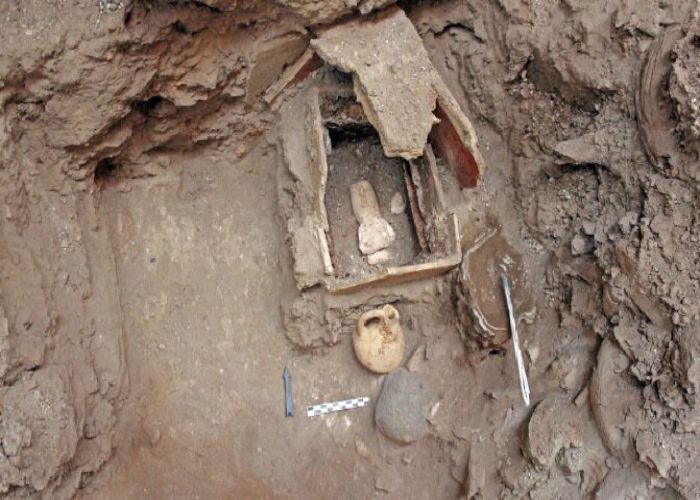
As already mentioned above, from the findings of the excavations, it is now known that the area of the Akrotiri archaeological site was inhabited during the Late Neolithic period -around 4500 BC- and during the 18th century BC. had developed into a city. At the beginning of the 17th century BC, it was leveled by an earthquake but was rebuilt on the ruins and flourished during the Late Cycladic I period until its burial by the Minoan eruption.
The location was ideal for a safe anchorage, as it was protected from the north winds, while at the same time, the morphology of the soil favored the development of agricultural activities. It was probably the capital of the island, but this has not yet been confirmed. The area of the excavations is close to 14 acres, a small percentage of the prehistoric city, which is estimated to have been about 200 acres and had around 30,000 inhabitants.
The settlement was dense and had high-rise buildings with rich frescoes, organized warehouses, craft spaces, excellent urban planning with streets, squares, and a fully developed sewer system, which passed under the cobblestones and was directly connected to the houses.
The building materials were stones, clay, and mud bricks reinforced with straw, wood, and plaster inside and out. A large number of murals, with which many of the spaces of the buildings were decorated, as a rule of the upper floors, indicate a sophisticated and refined urban society, which was dressed with luxury, elegance, and impressive multicolor.
The lower floors were used as warehouses, workshops, or mills, while the upper floors were the living quarters of the inhabitants. In the more affluent houses, the walls of the upper floors were often decorated with frescoes. The city streets were paved.
As soon as you step foot on the archaeological site of Akrotiri, you will be taken aback by the complexity of the structures. Every corner of the site is worth your time, however, make sure you don’t miss the most important monuments listed below.
The most important monuments:
Xesti 3: A large, at least two-story building with 14 rooms on each floor, with many of the rooms connected to each other. All rooms were also painted.
Sector B: It probably included two separate buildings stuck to each other. From the floor of the western building came the frescoes with the Antelopes and the Boxers, while from the eastern, the fresco of the Monkeys.
West House: A small but organized building. On the ground floor, there are food warehouses, laboratory areas, and a kitchen. The first floor has a spacious room where looms were installed, a warehouse for utensils and food, a toilet, and two consecutive murals.
Complex D: It consists of four buildings. One room of the east building was found decorated with the fresco of Spring, while all the buildings of Complex D gave great mobile finds.
Women's House: The fresco of Women and the Papyri was found in this building.
Xesti 4: A majestic three-story building. It is the largest excavated so far and it most likely was a public building.
Museum of Prehistoric Thera in Santorini
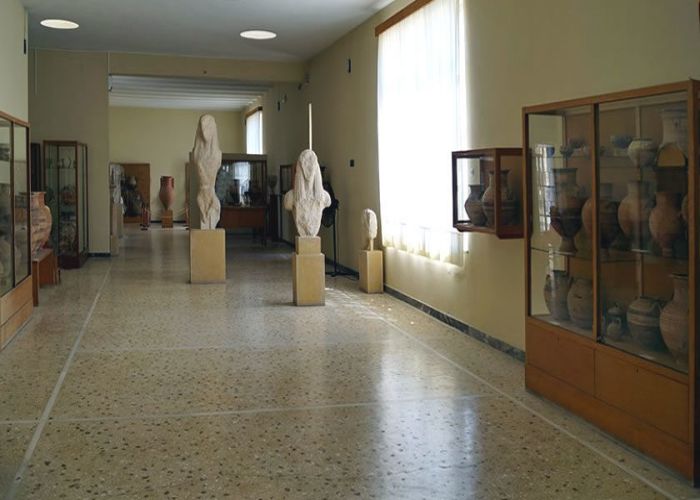
Those who visit the Museum of Prehistoric Thira in Fira during their Santorini vacations will have the opportunity to get to know the course of Thera in prehistoric times through selected findings. It is arguably one of the most important museums in Greece, with findings from both Akrotiri and the whole island.
The idea for the construction of a local museum exclusively for the findings of the excavations of Akrotiri belongs to the excavator of the prehistoric settlement, Professor Spyridon Marinatos. Its construction began in the early 1970s, with its completion taking place about ten years later, in the early 1980s.
In August 1999, the relevant funds were allocated for the organization of the exhibition, which began immediately and ended in eight months, while the second floor was adapted to meet the needs of a modern museum.
The museum can be considered as an extension of the archaeological site of Akrotiri, as it houses the frescoes and movable finds of this urban center during its heyday, namely the 17th century BC. At the same time, it hosts finds from many other places of Thera that date from the 5th millennium BC. -the Late Neolithic period- until the 17th c. e.g. and show the passage of various cultures from the Aegean.
At the Museum of Prehistoric Thira, you will see the following:
Thera from the Neolithic era to the seismic catastrophe: The showcases of room C outline the course of the island from the Late Neolithic Period to the beginning of the Late Cycladic Period. It includes Neolithic pottery, Early Cycladic figurines, and vases, Early Cycladic pottery, etc.
The discovery of an archeological site: In the vestibule, A of the Museum are exhibited images and texts that refer to the history of the research of prehistoric Thera. The excavations that took place on the island at the end of the 19th century, in Thirasia, in Akrotiri, and elsewhere are presented.
The geology of Thera: The small exhibition in area B chronicles the geological course of Thera, with intense volcanic activity, which seems to have begun about 1.5 million years ago.
The city of Akrotiri at its peak: The period of the prosperity of Akrotiri (17th century BC) comes to life with the development of areas of life and activity of the inhabitants of the prehistoric city.
The murals: Among the most impressive exhibits of the museum are the mural ensembles and excerpts of others found in private and public buildings of the city of Akrotiri and exhibited in room D3: mural of Women and Papyrus, the mural of Spring with flirtatious swallows are the best known.
The jewels found in Akrotiri archaeological site are few, apparently because the inhabitants took the valuables with them before leaving the city. Beads and forks made of semi-precious stones, bone, and copper are on display in Room D6. Room D7 exhibits clay pots from various regions of the Aegean, stone utensils from Crete and the Eastern Mediterranean, as well as murals with exotic themes.
The Museum of Prehistoric Thira is open daily except for Mondays from 08:30 to 15:00. Its address is Fira, Thira 84700. While you can find out more information about everything, you want to know by calling (+30) 22860 23217.
Guided tours of Akrotiri
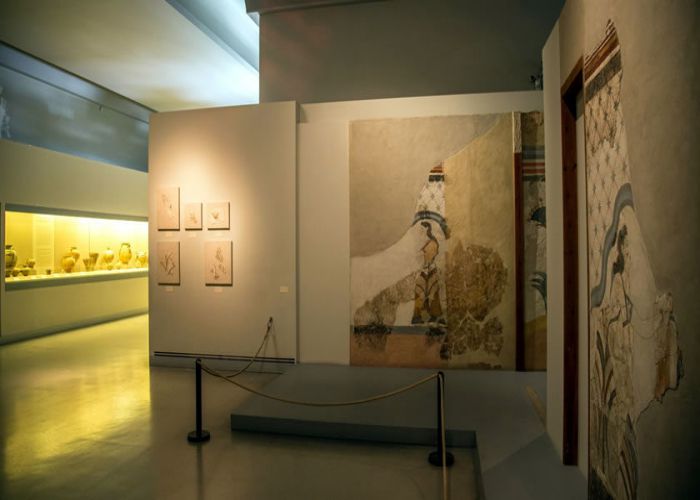
It takes no Sherlock Holmes to figure out that the best way to experience the archaeological site of Akrotiri, one of the most significant archaeological sites worldwide, is through a guided tour. A licensed expert will help you understand the sights before you. They will explain and unravel the ancient world of Santorini, giving you insight into a culture that has been preserved for thousands of years.
To enjoy a walk around the archeological site of Akrotiri and explore its full potential, you can embark on our Santorini private full-day tour with Akrotiri and wine-tasting. This way you will combine two of the island’s best elements: its history and wine production in a day filled with comfort and new adventures.
Alternatively, you can choose to book a Bespoke Santorini: Private Customized Tour With Driver-Guide and have complete control over your itinerary. You can always check our Santorini tours page as well for more inspiration!
Why do people believe that Santorini is the lost Atlantis?
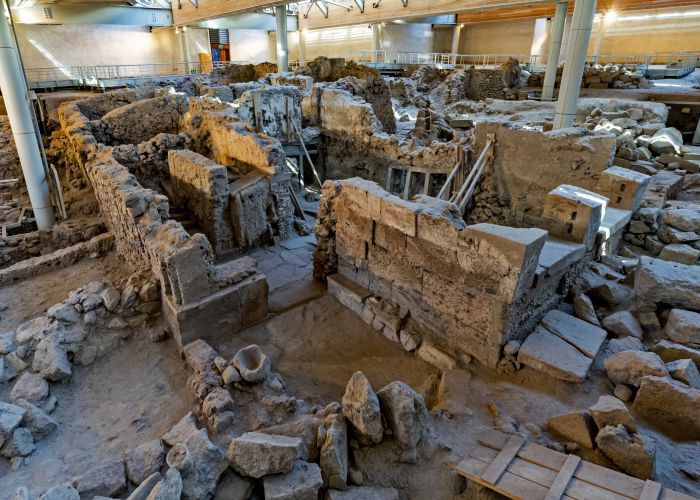
The history of Santorini is marked by the great eruption of the volcano in the 17th century BC. The morphology and shape of the island before the eruption of Thera were completely different. It was an almost round island with a second island in the middle.
According to experts, the eruption of the volcano was the strongest that humanity has known in the last 10,000 years. Such was its power that billions of tons of mass were fired at a height of 35 kilometers.
Santorini has associated its name with the myth of the lost Atlantis. According to the proponents of this theory, Atlantis is part of the island that disappeared after the eruption.
The mystery of Atlantis is perhaps the most talked-about myth. However, no one can prove that the city of Atlantis actually existed and exactly where it was located. However, some scientists claim that the destruction of the Minoan civilization and ancient Thera is associated with the lost Atlantis.
The first written references to Atlantis come from the Athenian philosopher Plato, who tells us that the Atlanteans were a people of supernatural abilities and divine descent, living peacefully on a fertile island beyond the Gates of Heraclides. In ancient times, the Gates of Heraklion were the straits of Gibraltar, so it was probably located somewhere between Europe and America.
The Atlanteans gradually began to lose their divine power. When overwhelmed by human weaknesses, they decided to turn against other affluent peoples in order to submit. That is why they traveled to the Mediterranean until they met the all-powerful and brave Athenians, from whom they were defeated for the first time. But after exhausting battles, the Athenians finally bowed. The gods then became angry with the Atlanteans and decided to punish them with eternal annihilation. The rage was so great that they destroyed them in just one night, leaving behind only masses of mud and thick smoke.
What does Santorini have in common with the lost Atlantis? Ancient Thira was a perfect earthly paradise, destroyed around 1,500 BC, along with a multitude of neighboring beaches, enticing brilliant specimens of Aegean civilization. Ancient Thera’s description fits perfectly with Plato's words about the mythical land of the Atlanteans that was completely destroyed, leaving no trace behind.
The name Atlantis probably comes from the mythical giant ‘Atlas,’ who, according to Greek Mythology, held the whole earth and sky on his shoulders. According to the discoveries of American geologists in Santorini in 1990, everything refers to the famous mural found in the western building of the Cape.
There, one can see the beach of ancient Thira with a prosperous life on a central island that was encircled by the sea all around. Just as Plato described the lost Atlantis. And this island is claimed to have disappeared from a large eruption that caused terrible earthquakes and smoke. According to Plato, smoke was released into the sky, 40 kilometers high. If so, then it was certainly visible from the shores of the Eastern and Central Mediterranean. People watched the make-up of nature in bewilderment, daring to see Atlas himself holding the sky on his shoulders.
What was the connection between the Minoan Kingdom and the ancient settlement of Akrotiri?
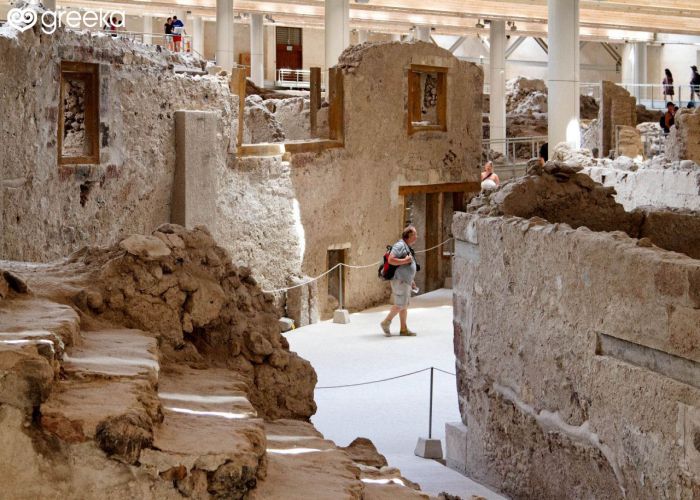
Somewhere between myth and history, two real events emerged that shocked the then-known Greek area about 3,500 years ago: the destruction of the Minoan Civilization and the eruption of the volcano of Santorini.
Archaeologists and scientists have linked the events, believing that the destruction of the Minoan civilization was caused by the violent eruption of the Santorini volcano.
Initially, it was believed that the eruption of the volcano took place in 1450 BC when the Minoan Palaces were destroyed, but today it is believed that the eruption took place earlier, somewhere between 1627 and 1600 BC.
The cosmogenic event of the eruption of the Volcano obviously could not leave Crete intact, which is so close to Santorini. The volcanic ash of the Santorini volcano covered the Minoan city at the Cape of Thira, covered the Aegean sky, and reached as far as Crete.
But was it enough to destroy the mighty civilization? For many years the views of archaeologists and scientists continue to be up for debate.
Final Thoughts
The archaeological site of Akrotiri is a sight no visitor of Santorini should miss and one of the most significant archaeological sites in Greece and the rest of the world.
In fact, it is so important that you won't find a single one of our Greece vacation packages visiting Santorini excluding it from their itinerary.
Regardless of how many days you have at your disposal or the type of vacation you want to experience, a visit to Akrotiri is essential.
It is perfect for solo travelers, those who visit Santorini with kids, or even those who are looking to put a cultural twist into their Santorini honeymoon. Watch the ancient Greek world come to life with the help of a local guide, and you’ll never look at Santorini in the same way again!





